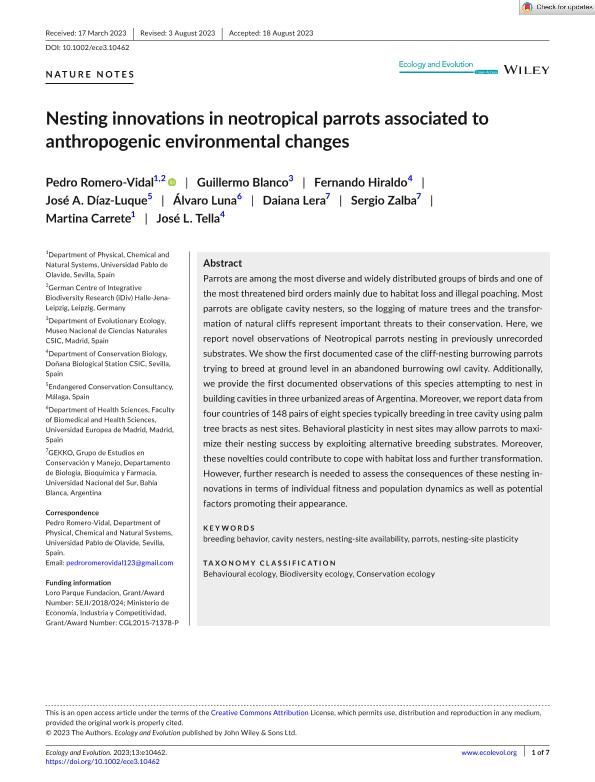Artículo
Nesting innovations in neotropical parrots associated to anthropogenic environmental changes
Romero Vidal, Pedro; Blanco, Guillermo; Hiraldo, Fernando; Díaz Luque, José A.; Luna, Álvaro; Lera, Daiana Noelia ; Zalba, Sergio Martín
; Zalba, Sergio Martín ; Carrete, Martina
; Carrete, Martina ; Tella, José L.
; Tella, José L.
 ; Zalba, Sergio Martín
; Zalba, Sergio Martín ; Carrete, Martina
; Carrete, Martina ; Tella, José L.
; Tella, José L.
Fecha de publicación:
09/2023
Editorial:
Wiley
Revista:
Ecology and Evolution
ISSN:
2045-7758
e-ISSN:
2045-7758
Idioma:
Inglés
Tipo de recurso:
Artículo publicado
Clasificación temática:
Resumen
Parrots are among the most diverse and widely distributed groups of birds and one of the most threatened bird orders mainly due to habitat loss and illegal poaching. Most parrots are obligate cavity nesters, so the logging of mature trees and the transformation of natural cliffs represent important threats to their conservation. Here, we report novel observations of Neotropical parrots nesting in previously unrecorded substrates. We show the first documented case of the cliff-nesting burrowing parrots trying to breed at ground level in an abandoned burrowing owl cavity. Additionally, we provide the first documented observations of this species attempting to nest in building cavities in three urbanized areas of Argentina. Moreover, we report data from four countries of 148 pairs of eight species typically breeding in tree cavity using palm tree bracts as nest sites. Behavioral plasticity in nest sites may allow parrots to maximize their nesting success by exploiting alternative breeding substrates. Moreover, these novelties could contribute to cope with habitat loss and further transformation. However, further research is needed to assess the consequences of these nesting innovations in terms of individual fitness and population dynamics as well as potential factors promoting their appearance.
Archivos asociados
Licencia
Identificadores
Colecciones
Articulos(CCT - BAHIA BLANCA)
Articulos de CTRO.CIENTIFICO TECNOL.CONICET - BAHIA BLANCA
Articulos de CTRO.CIENTIFICO TECNOL.CONICET - BAHIA BLANCA
Citación
Romero Vidal, Pedro; Blanco, Guillermo; Hiraldo, Fernando; Díaz Luque, José A.; Luna, Álvaro; et al.; Nesting innovations in neotropical parrots associated to anthropogenic environmental changes; Wiley; Ecology and Evolution; 13; 9; 9-2023; 1-7
Compartir
Altmétricas



